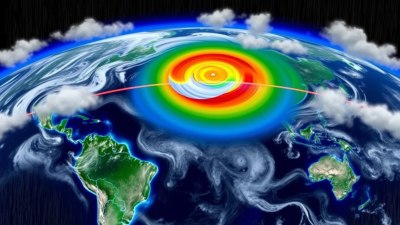Why the Sun Turns Into a Giant Mood Ring at Dusk
Explore the science behind the stunning colors of sunset and why the sun resembles a mood ring.

This image was created with the assistance of Freepik
As the day winds down and the sun begins its descent towards the horizon, a remarkable transformation occurs in the sky. The sun, typically a bright yellow or white hue during the day, morphs into a breathtaking kaleidoscope of colors, reminiscent of a giant mood ring. This phenomenon, often captivating onlookers, invites a deeper understanding of the science behind these stunning sunset hues. In this article, we delve into the various factors that contribute to the mesmerizing colors displayed by the sun at dusk.
The Science of Light
To comprehend why the sun appears to change colors during sunset, we must first understand the fundamental principles of light. Sunlight, or white light, is composed of various colors that correspond to different wavelengths of light. When passed through a prism, sunlight can be separated into its component colors: red, orange, yellow, green, blue, indigo, and violet. The longer the wavelength, the more red and orange light dominates, while shorter wavelengths produce blues and violets.
Rayleigh Scattering Explained
One of the key factors responsible for the color changes we observe during sunset is a phenomenon called Rayleigh scattering. This occurs when light interacts with particles in the Earth's atmosphere, such as air molecules and small particles like dust and pollution. During the day, when the sun is overhead, sunlight travels a shorter distance through the atmosphere, causing the shorter blue wavelengths to dominate and creating a blue sky.
However, as the sun begins to set, its light has to travel a longer path through the atmosphere to reach our eyes. This extended journey causes more scattering of the shorter blue wavelengths, allowing the longer wavelengths—especially reds and oranges—to become more prominent. Thus, as the sun lowers, it creates an array of warm colors that resemble the shifting tones of a mood ring.
The Role of Atmospheric Conditions
The saturation and variety of colors observed during sunset can be significantly enhanced by existing atmospheric conditions. Factors such as humidity, temperature, and the presence of particles like dust or smoke can play a pivotal role in the intensity and range of colors that we see. For instance, in areas with high humidity or after a rainstorm, the increased moisture in the air can lead to more vibrant sunsets due to a more effective scattering of sunlight.
On the other hand, pollution can also heighten the colors seen during sunset, as particulates in the atmosphere scatter different wavelengths of light. Interestingly, while pollution might not be desirable, it can inadvertently create some of the most striking sunset displays—something that ties back to the scientific principle of light scattering.
City Lights and Urban Sunsets
In urban environments, the interplay between city lights and natural twilight can yield dynamic displays at dusk. Urban light pollution can superimpose an artificial glow onto the natural colors of a sunset, which can create unique contrasts. The combination of natural atmospheric light scattering with the artificial spectrum of city lights adds another layer to the ‘mood ring’ effect we observe at dusk in cities.
The Psychology of Color
The impact of color on human psychology is another factor we should consider when discussing the sunset's resemblance to a mood ring. Colors evoke emotions and can influence feelings. Warm colors like red, orange, and yellow are often associated with feelings of warmth, comfort, and safety while cooler tones like blue and green can evoke feelings of calmness and relaxation.
During sunset, as the dominant colors shift towards warm hues, viewers often experience a sense of peace and tranquility. This emotional connection to color can make the sunset feel even more like a giant mood ring, reflecting not just physical changes in light but also the feelings they evoke in observers.
Seasonal Variations
Sunsets can also differ remarkably depending on the season. During the summer months, longer days and different atmospheric compositions can contribute to consistently breathtaking sunsets, often featuring vibrant oranges and pinks. In contrast, during the winter, the sun sets more quickly, leading to shorter twilight and altering the palette of colors that are visible. These seasonal variations further enrich the experience, providing diverse displays of what could be described as the sun’s ‘mood’ at different times of the year.
Sunset Views Around the World
The experience of watching a sunset varies across the globe, with different locations offering distinct perspectives and influences on sunset colors. Some of the most renowned places to witness spectacular sunsets include Santorini in Greece, the Grand Canyon in the USA, and Tanjung Aru in Malaysia. Each of these locations offers unique atmospheric conditions and scenic backdrops that can enhance the sunset experience.
For instance, Santorini is known for its stunning sunsets over the Aegean Sea, where the interplay between water and light creates magnificent reflections and shimmering colors. In the Grand Canyon, the sun sets over the vast landscape, highlighting the varied rock formations and shadow play that captures the essence of the moment. These global variations in sunset settings highlight the beauty and diversity in experiencing a sunset and how it may influence the perceived ‘mood’ of the sun.
Capturing the Moment
For many, watching a sunset is a ritual that holds significance, prompting individuals to pause and reflect as day transitions into night. Photographers and artists alike are drawn to sunsets, striving to capture these fleeting moments of beauty. The varying colors and dynamic interactions of light encourage creativity, further cementing the sunset’s identity as a representation of a mood ring.
Today, with the rise of social media, sharing sunset images has become a popular pastime, allowing individuals to showcase their experiences and encourage others to take a moment to appreciate these daily occurrences. The shared human experience of witnessing a sunset can foster connection and appreciation for the natural world.
In conclusion, the sun’s transformation into a giant mood ring at dusk is an outstanding interplay of physics, biology, and human emotion. Understanding the science of light, the role of atmospheric conditions, and the psychological impacts of color can significantly enhance our appreciation for this natural wonder. Whether you are standing on a serene beach, a bustling cityscape, or atop a mountain, the sunset reminds us of the beauty that surrounds us and the ability of color to influence our emotions. So next time you find yourself watching a sunset, take a moment to reflect on the colorful tapestry woven in the sky and the myriad emotions it can evoke.











